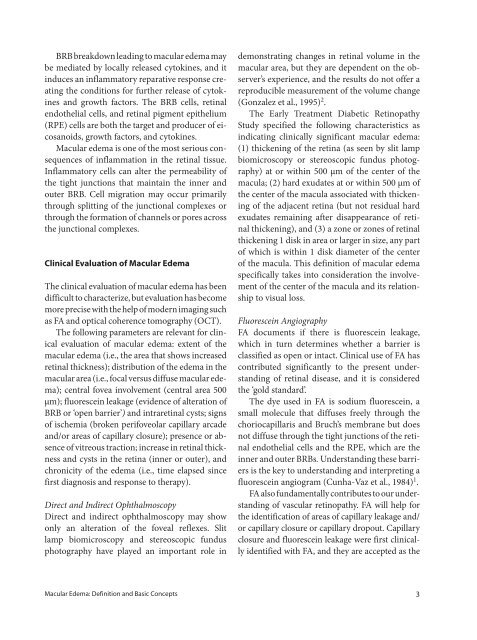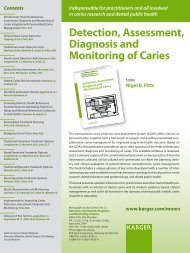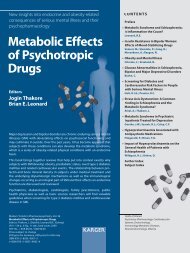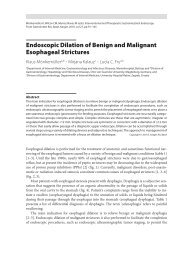Macular Edema: Definition and Basic Concepts - Karger
Macular Edema: Definition and Basic Concepts - Karger
Macular Edema: Definition and Basic Concepts - Karger
You also want an ePaper? Increase the reach of your titles
YUMPU automatically turns print PDFs into web optimized ePapers that Google loves.
BRB breakdown leading to macular edema may<br />
be mediated by locally released cytokines, <strong>and</strong> it<br />
induces an inflammatory reparative response creating<br />
the conditions for further release of cytokines<br />
<strong>and</strong> growth factors. The BRB cells, retinal<br />
endothelial cells, <strong>and</strong> retinal pigment epithelium<br />
(RPE) cells are both the target <strong>and</strong> producer of eicosanoids,<br />
growth factors, <strong>and</strong> cytokines.<br />
<strong>Macular</strong> edema is one of the most serious consequences<br />
of inflammation in the retinal tissue.<br />
Inflammatory cells can alter the permeability of<br />
the tight junctions that maintain the inner <strong>and</strong><br />
outer BRB. Cell migration may occur primarily<br />
through splitting of the junctional complexes or<br />
through the formation of channels or pores across<br />
the junctional complexes.<br />
Clinical Evaluation of <strong>Macular</strong> <strong>Edema</strong><br />
The clinical evaluation of macular edema has been<br />
difficult to characterize, but evaluation has become<br />
more precise with the help of modern imaging such<br />
as FA <strong>and</strong> optical coherence tomography (OCT).<br />
The following parameters are relevant for clinical<br />
evaluation of macular edema: extent of the<br />
macular edema (i.e., the area that shows increased<br />
retinal thickness); distribution of the edema in the<br />
macular area (i.e., focal versus diffuse macular edema);<br />
central fovea involvement (central area 500<br />
μm); fluorescein leakage (evidence of alteration of<br />
BRB or ‘open barrier’) <strong>and</strong> intraretinal cysts; signs<br />
of ischemia (broken perifoveolar capillary arcade<br />
<strong>and</strong>/or areas of capillary closure); presence or absence<br />
of vitreous traction; increase in retinal thickness<br />
<strong>and</strong> cysts in the retina (inner or outer), <strong>and</strong><br />
chronicity of the edema (i.e., time elapsed since<br />
first diagnosis <strong>and</strong> response to therapy).<br />
Direct <strong>and</strong> Indirect Ophthalmoscopy<br />
Direct <strong>and</strong> indirect ophthalmoscopy may show<br />
only an alteration of the foveal reflexes. Slit<br />
lamp biomicroscopy <strong>and</strong> stereoscopic fundus<br />
photography have played an important role in<br />
demonstrating changes in retinal volume in the<br />
macular area, but they are dependent on the observer’s<br />
experience, <strong>and</strong> the results do not offer a<br />
reproducible measurement of the volume change<br />
(Gonzalez et al., 1995) 2 .<br />
The Early Treatment Diabetic Retinopathy<br />
Study specified the following characteristics as<br />
indicating clinically significant macular edema:<br />
(1) thickening of the retina (as seen by slit lamp<br />
biomicroscopy or stereoscopic fundus photography)<br />
at or within 500 μm of the center of the<br />
macula; (2) hard exudates at or within 500 μm of<br />
the center of the macula associated with thickening<br />
of the adjacent retina (but not residual hard<br />
exudates remaining after disappearance of retinal<br />
thickening), <strong>and</strong> (3) a zone or zones of retinal<br />
thickening 1 disk in area or larger in size, any part<br />
of which is within 1 disk diameter of the center<br />
of the macula. This definition of macular edema<br />
specifically takes into consideration the involvement<br />
of the center of the macula <strong>and</strong> its relationship<br />
to visual loss.<br />
Fluorescein Angiography<br />
FA documents if there is fluorescein leakage,<br />
which in turn determines whether a barrier is<br />
classified as open or intact. Clinical use of FA has<br />
contributed significantly to the present underst<strong>and</strong>ing<br />
of retinal disease, <strong>and</strong> it is considered<br />
the ‘gold st<strong>and</strong>ard’.<br />
The dye used in FA is sodium fluorescein, a<br />
small molecule that diffuses freely through the<br />
choriocapillaris <strong>and</strong> Bruch’s membrane but does<br />
not diffuse through the tight junctions of the retinal<br />
endothelial cells <strong>and</strong> the RPE, which are the<br />
inner <strong>and</strong> outer BRBs. Underst<strong>and</strong>ing these barriers<br />
is the key to underst<strong>and</strong>ing <strong>and</strong> interpreting a<br />
fluorescein angiogram (Cunha-Vaz et al., 1984) 1 .<br />
FA also fundamentally contributes to our underst<strong>and</strong>ing<br />
of vascular retinopathy. FA will help for<br />
the identification of areas of capillary leakage <strong>and</strong>/<br />
or capillary closure or capillary dropout. Capillary<br />
closure <strong>and</strong> fluorescein leakage were first clinically<br />
identified with FA, <strong>and</strong> they are accepted as the<br />
<strong>Macular</strong> <strong>Edema</strong>: <strong>Definition</strong> <strong>and</strong> <strong>Basic</strong> <strong>Concepts</strong> 3
















